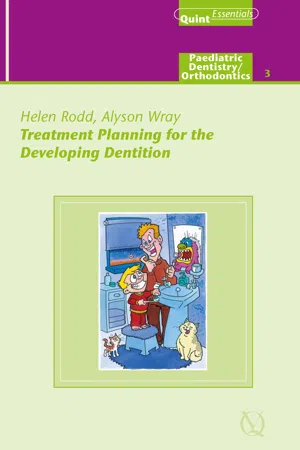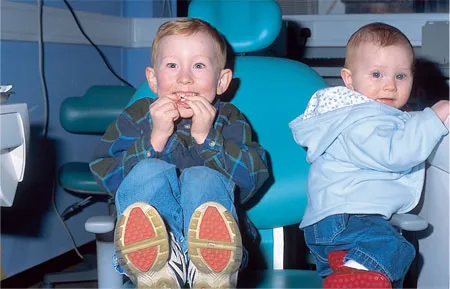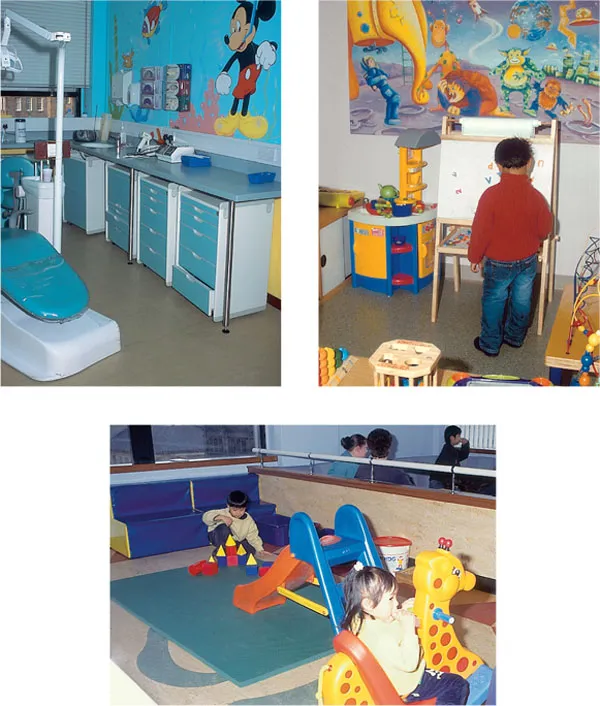
eBook - ePub
Treatment Planning for the Developing Dentition
Alyson P. Wray, Helen D. Rodd
This is a test
Buch teilen
- 150 Seiten
- English
- ePUB (handyfreundlich)
- Über iOS und Android verfügbar
eBook - ePub
Treatment Planning for the Developing Dentition
Alyson P. Wray, Helen D. Rodd
Angaben zum Buch
Buchvorschau
Inhaltsverzeichnis
Quellenangaben
Über dieses Buch
This book presents the basic principles underlying sound treatment planning for the young patient, whose early experiences can significantly affect future behavior and attitudes. Treatment planning is not merely a sequence of procedures, but should address the individual social, medical, and dental needs of each child.
Häufig gestellte Fragen
Wie kann ich mein Abo kündigen?
Gehe einfach zum Kontobereich in den Einstellungen und klicke auf „Abo kündigen“ – ganz einfach. Nachdem du gekündigt hast, bleibt deine Mitgliedschaft für den verbleibenden Abozeitraum, den du bereits bezahlt hast, aktiv. Mehr Informationen hier.
(Wie) Kann ich Bücher herunterladen?
Derzeit stehen all unsere auf Mobilgeräte reagierenden ePub-Bücher zum Download über die App zur Verfügung. Die meisten unserer PDFs stehen ebenfalls zum Download bereit; wir arbeiten daran, auch die übrigen PDFs zum Download anzubieten, bei denen dies aktuell noch nicht möglich ist. Weitere Informationen hier.
Welcher Unterschied besteht bei den Preisen zwischen den Aboplänen?
Mit beiden Aboplänen erhältst du vollen Zugang zur Bibliothek und allen Funktionen von Perlego. Die einzigen Unterschiede bestehen im Preis und dem Abozeitraum: Mit dem Jahresabo sparst du auf 12 Monate gerechnet im Vergleich zum Monatsabo rund 30 %.
Was ist Perlego?
Wir sind ein Online-Abodienst für Lehrbücher, bei dem du für weniger als den Preis eines einzelnen Buches pro Monat Zugang zu einer ganzen Online-Bibliothek erhältst. Mit über 1 Million Büchern zu über 1.000 verschiedenen Themen haben wir bestimmt alles, was du brauchst! Weitere Informationen hier.
Unterstützt Perlego Text-zu-Sprache?
Achte auf das Symbol zum Vorlesen in deinem nächsten Buch, um zu sehen, ob du es dir auch anhören kannst. Bei diesem Tool wird dir Text laut vorgelesen, wobei der Text beim Vorlesen auch grafisch hervorgehoben wird. Du kannst das Vorlesen jederzeit anhalten, beschleunigen und verlangsamen. Weitere Informationen hier.
Ist Treatment Planning for the Developing Dentition als Online-PDF/ePub verfügbar?
Ja, du hast Zugang zu Treatment Planning for the Developing Dentition von Alyson P. Wray, Helen D. Rodd im PDF- und/oder ePub-Format sowie zu anderen beliebten Büchern aus Medicine & Dentistry. Aus unserem Katalog stehen dir über 1 Million Bücher zur Verfügung.
Information
Chapter 1
The First Visit
Aim
In this chapter the importance of introducing a young child to dentistry is emphasised and a strategy for structuring dental treatment is outlined.
Objectives
After reading this chapter the dentist should be able to:
- understand the importance of the child’s early impressions
- plan first visits according to the age of the child
- appreciate the need for a thorough history and clinical examination
- undertake caries risk assessment
- understand the need to initiate a hierarchical treatment plan.
Introduction
Children are the adult dental patients of the future, and good groundwork in the early years of dental monitoring and treatment planning will pay dividends in both the short and long term (Fig 1-1). Furthermore, children are infinitely variable in their behaviour, their development and in their dental needs, and therefore one of the key aims of this book is to establish the importance of individualising treatment planning and dental care.

Fig 1-1 Two pre-school children exploring the dental environment.
There are many reasons why appropriate treatment planning is important – for example, the avoidance of unnecessary treatment such as repeat general anaesthetics or endodontic treatment on a tooth with an unrestorable crown, the facilitation of future interventions, such as retaining roots to maintain alveolar bone, and reduction in stress for operators and patients. It is particularly important with young patients to set easily achievable targets for each visit and for the overall treatment plan. The overall aims of a course of treatment may be very different from those for an adult patient.
First Visit – First Impressions
We are all aware that first impressions can be lasting ones. It is very important that any child’s introduction to dentistry leaves as favourable an impression as possible. This is one of the many reasons why it is so helpful if children begin attending when they have no immediate treatment need. A child who first attends in pain and who may require operative treatment at that visit will have a very different first impression from one who attends symptom-free and only requires a dental examination. For an overview of the approach for a child presenting in pain see Chapter 5.
It is usually beneficial to give children a morning appointment. Although parents may be resistant to this, preferring appointments after school, many young children are tired and hungry at this time of day, and their behaviour is affected accordingly. Seeing young children in the morning, when you are both relatively fresh, is usually more productive.
Wherever possible the practice environment should be child-friendly. Bright decorations, good lighting, simple toys or games in the waiting area go a long way to making a positive first impression. All appointments run late from time to time, but ideally children, in particular anxious ones, should not be kept waiting. If waiting is unavoidable, toys, storybooks and appropriate videos will help to make the wait more pleasant (Fig 1-2).

Fig 1-2 Child-friendly surgery and waiting areas.
Dental practices are very busy places, and it is commonplace for the dentist to stay in the surgery for most of the session and have the dental nurse go to the waiting room to escort the patients to the surgery. This is usually acceptable for adult patients, and those who are very familiar with, and relaxed in, the dental environment. For new, young patients it is much less intimidating if the dentist greets the child in the waiting room, with an accompanying adult close at hand, and then escorts the child into the surgery. Remember that eye contact is very important, in particular at a first meeting. It may be necessary to bend down, or even kneel, to make good eye contact with a small child. Communication involves words (verbal), tone and actions (non-verbal). With children, the verbal component is the least important.
Parent in or out of the Surgery: the Treatment Triangle
Whether or not to have parents in the dental surgery during treatment of their child is an issue most dentists feel quite strongly about. Some advocate always having parents present, others would say never. In reality, it is probably inappropriate to have a hard and fast rule. It is well documented that separation anxiety begins to develop in children around the age of eight or nine months, usually peaks around two to three years of age and for most has dwindled again by the age of five. It would seem reasonable, therefore, to have children accompanied by their parent or carer until the age of three or four, and to make individual decisions about accompaniment from then on (Fig 1-3). A self-confident four-year-old who knows the dentist well will happily sit for a check-up on his or her own. An anxious five-year-old, new to the practice, who needs a first local anaesthetic should, however, have a parent present, provided that the parent has a positive effect on the child’s behaviour.

Fig 1-3 Parental presence is important to reassure very young children in an unfamiliar environment.
It is helpful to establish with the parent that his or her role is to provide support for the child, not to become a communication barrier between the dentist and the patient. An outline of the pros and cons of having parents in the surgery is given in Table 1-1. More detail is given in another volume in this series, Child Taming (see recommended reading).
| Pro | Con |
|
|
The Child is Part of the Family
Before any treatment plan can be drafted, the process of information-gathering must be completed. This can begin even before the first visit, as many children will be part of families already attending the practice. Thus knowledge of the family’s attitude towards dentistry and dental treatment, together with the family history of dental needs, provides a useful base for treatment planning.
Ideally young children should be regular dental attenders as part of family visits from the time of tooth eruption. In reality many children do not attend for dental care until the age of three or four, or until they are experiencing symptoms. Later in this chapter some examples of treatment plans for different age groups are given by way of suggestions for the possible structuring of a series of appointments.
Information Gathering
There are varying opinions regarding the degree of formality appropriate between the dentist and the patient: where children are concerned, it is usually helpful to be informal and to pr...